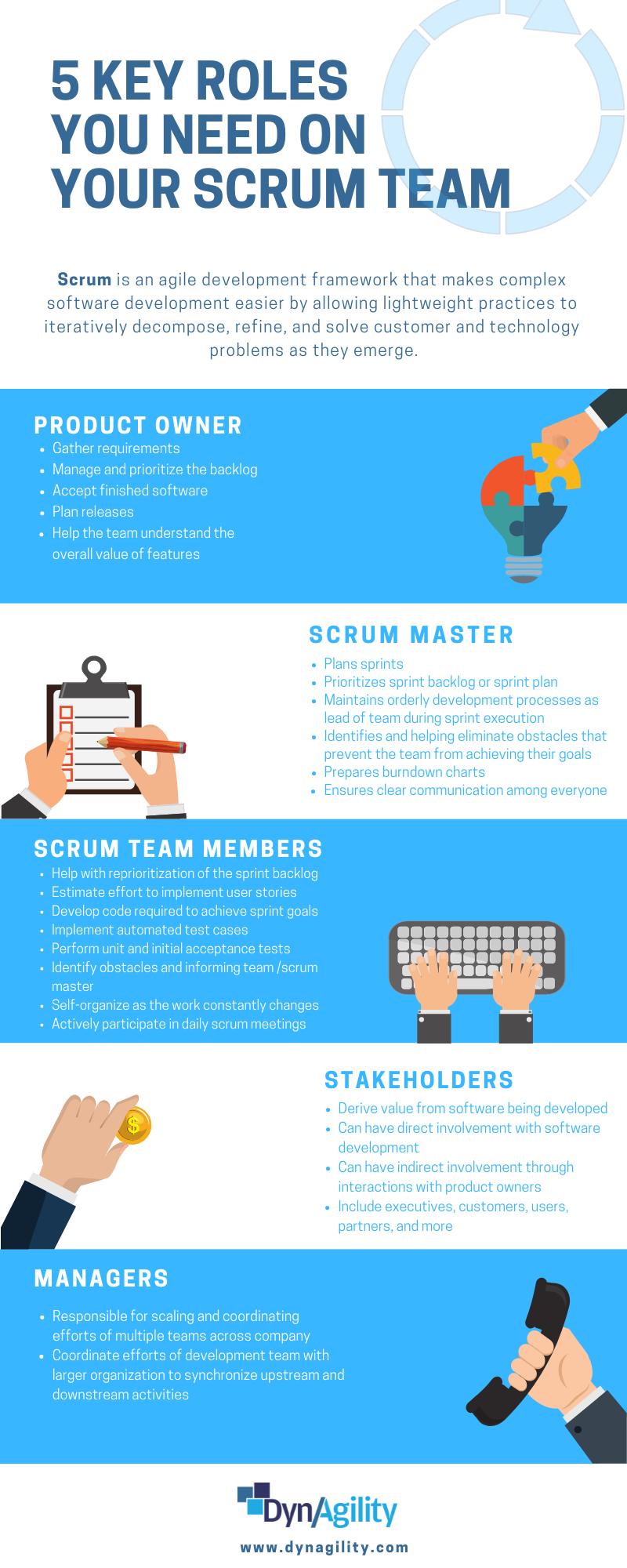Who’s Playing? A Brief Guide To The Roles of Agile Scrum
Do You Know Who’s In Your Line Up?
Agile scrum is a flexible management framework in software development designed to make complex, long-lived software development easier. It leverages lightweight practices to iteratively decompose, refine, and solve customer and technology problems as they emerge.
Agile scrum is meant to be used as a guide, not a rigid set of rules. Organizations can adjust the framework to meet their needs, but it's important to have an understanding of the basics first.
At DynAgility, we’ve developed some best practices around the Agile Scrum framework. Let’s start by breaking down the fundamentals of the scrum team.
A Quick Intro to Agile Scrum Methodology:
Before we get into roles let’s understand some key guidelines. These principles build the foundation for your entire agile scrum process.
Scrum requires highly motivated, closely collaborating, cross-functional teams that can self-organize to resolve impediments, deliver creative solutions, and solve problems greater than could be solved without the combined strengths of a full team.
Scrum is a feedback-driven approach underpinned by the three pillars of transparency, inspection, and adaptation. All work within the framework should be visible to those responsible for the outcome
The framework requires teams of 3-9 members who break their work into actions that can be completed within time-boxed iterations called "sprints", no longer than one month and most commonly two weeks.
Do you know the key roles of your scrum team? Whether you’re building your first scrum team or you’re a seasoned pro, aligning key roles and players can make or break your agile development process.
There are 3 primary roles and 3 secondary roles. Each player brings their own unique contributions, but the scrum team operates as a single unit.
Primary Roles: Product Owner, Scrum Master, Scrum Team
Let’s take a look at the 3 primary roles first. These are the core of your team.
Product Owner - The Visionary
The product owner represents the product's stakeholders and the voice of the customer. He or she is the visionary for the software capabilities.
The Product Owner Is Responsible For:
Gathering requirements
Managing and prioritizing the backlog
Approving (or “accepting”) finished software
Planning releases
Helping the team understand the overall value of features
The Product Owner Needs To:
Understand the business and digital capabilities that are being provided to support it (domain expertise)
Working technical knowledge
Highly available to team at all times
Scrum Master - The Mentor
The scrum master focuses on development and ongoing optimization of team processes. He or she serves as the mentor for the scrum team.
The Scrum Master Is Responsible For:
Planning sprints
Prioritizing the sprint backlog (or sprint plan)
Maintaining orderly development processes during sprint execution
Identifying and helping to eliminate obstacles that prevent the team from achieving goals
Preparing burndown charts
Ensuring clear communication among everyone
The Scrum Master Needs To:
Have technical expertise
Understand the product owner’s vision
Be a good team player and mentor
Understand the team’s capabilities
Motivate and coach the team
Be a great problem solver
Scrum Team - The Builders
A scrum team is a very specialized development team in the way it is organized and how it executes better code, faster, and with higher customer satisfaction. The team is comprised of cross-functional members who are capable of achieving the broad sprint goals that change over time. Through the process of cross-training and mentorship by others, scrum team members develop a wide range of skills. As members broaden their skillset, they can solve more varied customer problems.
The Scrum Team Can Include:
Software engineers
Architects
Analysts
System administrators
QA experts
UI/UX designers
The Scrum Team Is Responsible For:
Helping with reprioritization of the sprint backlog (sprint plan) to handle emerging dependencies and impediments
Estimating the effort to implement user stories
Developing code required to achieve sprint goals on behalf of users
Implementing automated test cases
Performing unit and initial acceptance tests
Identifying obstacles and informing team /scrum master
Self-organizing as the work constantly changes
Actively participating in daily scrum meetings
The Scrum Team Needs To:
Understand paired programming
Conduct test driven development (TDD)
Conduct behavior driven development (BDD)
Consider constant refactoring
Conduct continuous integration
Maintain self and team motivation and organization
Strive to be a progressively better team player
Secondary Roles of Scrum: Stakeholders, Managers, and Agile Trainers
Let’s take a look at the secondary roles. Don’t downplay these roles when building your scrum team. They are often the decision makers in the bigger organizational picture.
While secondary players don’t have a formal role on the team and are less frequently involved in scrum activities, they can have a significant impact on the outcome of your project.
Stakeholders - The Decision Makers
Stakeholders are the people that derive value from the software being developed. They can have direct involvement with the software development during sprint reviews. They can also have indirect involvement through interactions with the POs who participate in every iteration of each feature.
Stakeholders Can Include:
Executives
Customers
Users
Customer Representatives
Partners
Investors
Managers - The Messengers
Managers coordinate the efforts of the development teams with the larger organization to synchronize upstream and downstream activities. As organizations grow, managers are required to scale up and coordinate the efforts of multiple teams across multiple locations.
Agile Trainers - The Experts
Agile trainers are outside the team and should only be viewed as catalysts for positive change. They engage with a team for a finite period of time to observe and improve the sprint execution or to help scale up to multiple teams, products, geographies, or corporate divisions.
There is a growing need for experts who have led large and varied agile development programs to help grow and refine agile development best practices across teams. Most often these are consultants, but in large development organizations they can be full time employees.
As you are building or redefining your scrum team, understanding each role’s contribution will help you determine the best players for each position. Also recognizing the influence of secondary roles on team decisions will help you avoid unnecessary roadblocks.
It’s important to note that while each of these roles are individually defined and filled, the scrum team works as a single unit. Individuals do not own mistakes or successes. Instead the scrum team as a whole is responsible for wins and losses, wholly owning the product.
However you choose to adapt the agile scrum framework to fit your team’s needs, selecting the right people for each role will grow accountability, communication, and adaptability across your team.
Subscribe
Sign up to receive updates and announcements from DynAgility.









